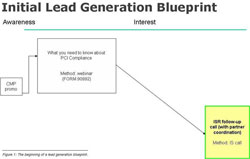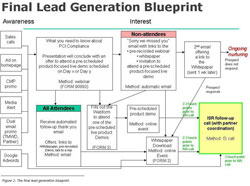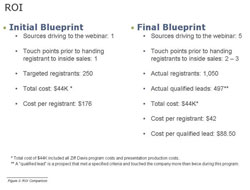
www.kickstartall.com
Lead Generation Blueprints in 30 Minutes: How one company quadrupled their marketing ROI
by
Mike Gospe
This article is the second in a series taken from Mike Gospe's new book, Marketing Campaign Development: what marketing executives need to know about architecting global integrated marketing campaigns. The book can be ordered by clicking here.
Not long ago one of my clients asked me to take on the role of an interim director of field marketing. This mid-sized Internet security company enjoys a solid customer base and a number of rich product offerings. But, with fierce competition and a lengthy sales process, the ability to produce well-qualified leads in a timely fashion has been difficult.
To meet their 2007 business objectives, the marketing team would have to stretch their limits. As is common with marketing teams everywhere, the fast pace of business continues to increase, meaning that the team members are almost always busy executing. This, in and of itself, is not a bad thing. Unfortunately, with so much going on, the overall strategy behind the lead generation activities (e.g., What is the definition of a "true" qualified lead? Who are we targeting and why? How are we nurturing these leads?) had been lost. They asked for my help to get them back on course.
The importance of developing lead generation blueprints
The first project I inherited was a webinar scheduled to take place in 3 weeks. The team had signed a contract for turn-key webinar services from Ziff Davis. These services included everything from list management, to ensuring a minimum of 250 people registered, to hosting the actual event. While the mechanics of the actual event was well taken care of, the strategy behind the event and how to use it effectively as a lead generation vehicle was sorely lacking.
To get a sense of the marketing assets at our disposal I asked a few key questions and received the following answers:
Q) What activities are driving people to the webinar?
A) Ziff Davis
is driving people to the webinar from their website.
Q) What happens after the webinar?
A) We'll send all registrants,
whether they attended or not to the inside sales team for follow-up.
|
Clearly, if left alone, the execution of this webinar in this skeletal fashion would likely result in only 250 registrants. After all, this was guaranteed by Ziff Davis. Unfortunately, the conversion rate of registrants to true leads doesn't happen by itself. We needed a more thoughtful and cleverer marketing program to make this happen.
Whereas most companies may shudder at the mere mentioning of the words "marketing strategy," I took a gamble and called a marketing/sales program meeting to further brainstorm on the webinar project. We followed the marketing blueprint technique illustrated in Marketing Campaign Development. Literally, within 30 minutes, we developed the blueprint illustrated in figure 2.
We started by answering the following 6 questions:
- Who is the target audience?
- How do they want to be communicated with?
- What offers do they want/expect from us?
- After they respond to the first activity and offer, what happens next? And what happens after that?
- What happens if they don't respond?
- How will these activities and offers help qualify these prospects?
Not unsurprisingly, the team knew the answers to all of these questions. They just didn't have a framework to collect and present the answers. The blueprint model did this for us.
Within 30 minutes, we concluded the following:
- Instead of just one website (Ziff Davis) promoting the webinar, we actually had 6 sources at our fingertips.
- Handing over the registrants to the inside sales team would waste too much time because no qualification information had yet been captured. However, if each registrant could be given multiple opportunities to engage with the company during the month of September, we could collect more valuable information as our dialog with them unfolded. In fact, we could easily separate out which prospects touched the company two or three times during the month and prioritize them, rather than going after "anybody with a pulse".
- We had multiple calls to action. We could create a "trail of breadcrumbs" for the prospect to follow. Based on their interest, they could decide which offer was most meaningful to them.
- We could also prepare a different dialog for prospects who attended the webinar, from those who did not. In this way, we could nurture each prospect as an individual, not a mass market.
When I started whiteboarding the revised blueprint, the team was totally engaged. In fact, several members jumped up to take a marker and add to the drawing. The excitement generated from that 30 minute session was quickly translated into action. Revisions were made, new landing pages were created, and the offers were updated and put on line. We also prepped the inside sales team so they knew what to expect.
|
The results speak for themselves and are summarized in figure 3. By using the blueprint technique to tighten up our campaign, we quadrupled the number of registrants and produced 497 well-qualified leads who met a carefully defined set of criteria and touched the company at least twice during this September program. Those leads were given top priority with the sales team and will be carefully watched and nurtured as they work through the 6-9 month sales process.
Applying these lessons to your marketing campaigns
Like we did here, marketers must continually fight the temptation of executing random, disconnected lead generation activities to our prospects. Because the world does not receive messages one marketing vehicle at a time, we can only hope to achieve success if we are thoughtful and pay attention to what we are saying, and when and how we are delivering the message. Success today requires marketers to apply the discipline of campaign development in order to establish a relevant, timely dialog with the target audience. This is the key to higher conversion rates and even higher customer loyalty.
Marketing Campaign Development is about applying these marketing blueprint practical lessons and best practices that have been adopted by hi-tech companies such as Aspect, Genesys, Hewlett-Packard, Informatica, and Symantec, and scores of others. Every company is different. But, I guarantee you that 80% of the process steps, templates, and techniques included in this book can be applied to your business with great success today. Click here to find out more and order a copy.
About the Author
Mike Gospe has helped companies like HP, Sun, Ariba,
Informatica, Symantec, and a number of startups architect
and execute winning marketing campaign processes and
plans. For more information on these and other tips and
tricks, please contact Mike at 650.947.8974.


